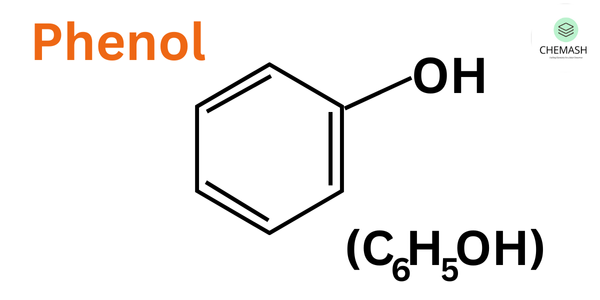Classification of Phenol
Phenols are aromatic compounds in which one or more hydroxyl (–OH) groups are directly attached to a benzene ring. Their classification is based on the number of –OH groups, the type of substituents, and the number of aromatic rings. Read here: Chemical Reactions of Phenol.

I. Based on Number of Hydroxyl Groups
- Monohydric Phenols: Contain only one –OH group.
Examples: Phenol (C₆H₅OH), o-Cresol, m-Cresol, p-Cresol - Dihydric Phenols (Diphenols): Contain two –OH groups on the benzene ring.
Examples: Catechol (1,2-), Resorcinol (1,3-), Hydroquinone (1,4-) - Trihydric Phenols: Contain three –OH groups.
Examples: Pyrogallol (1,2,3-), Phloroglucinol (1,3,5-)
II. Based on Nature of Substituents
- Simple Phenols: Have only hydroxyl group(s) without other substituents.
Examples: Phenol, Catechol, Resorcinol - Substituted Phenols: Have other substituents along with hydroxyl group(s), such as alkyl, halogen, or nitro groups.
Examples: o-Cresol, 4-Nitrophenol, 2,4,6-Tribromophenol
III. Based on Number of Aromatic Rings
- Mononuclear Phenols: Contain a single benzene ring with hydroxyl group(s).
Examples: Phenol, Resorcinol - Polynuclear Phenols: Contain multiple benzene rings with one or more hydroxyl groups.
Examples: α-Naphthol, β-Naphthol, Bisphenol A
Summary Table of Classification
| Classification Basis | Type | Examples |
|---|---|---|
| No. of –OH Groups | Mono, Di, Trihydric | Phenol, Catechol, Pyrogallol |
| Substituents | Simple, Substituted | Phenol, o-Cresol, 4-Nitrophenol |
| Aromatic Rings | Mononuclear, Polynuclear | Phenol, Bisphenol A, α-Naphthol |
Frequently Asked Questions
Q1: What are monohydric phenols?
Answer: Monohydric phenols contain a single hydroxyl (–OH) group attached to a benzene ring. Example: Phenol.
Q2: What is the difference between simple and substituted phenols?
Answer: Simple phenols contain only –OH group(s), while substituted phenols also have other substituents like alkyl, halogen, or nitro groups.
